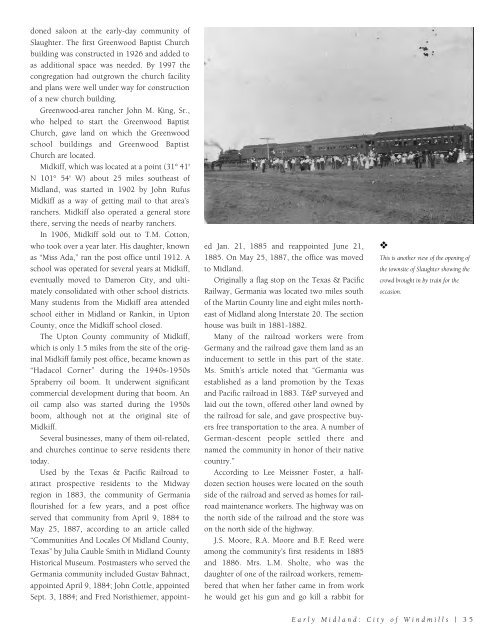Historic Midland
An illustrated history of the Midland County area, paired with the histories of companies, families and organizations that make the region great.
An illustrated history of the Midland County area, paired with the histories of companies, families and organizations that make the region great.
You also want an ePaper? Increase the reach of your titles
YUMPU automatically turns print PDFs into web optimized ePapers that Google loves.
doned saloon at the early-day community of<br />
Slaughter. The first Greenwood Baptist Church<br />
building was constructed in 1926 and added to<br />
as additional space was needed. By 1997 the<br />
congregation had outgrown the church facility<br />
and plans were well under way for construction<br />
of a new church building.<br />
Greenwood-area rancher John M. King, Sr.,<br />
who helped to start the Greenwood Baptist<br />
Church, gave land on which the Greenwood<br />
school buildings and Greenwood Baptist<br />
Church are located.<br />
Midkiff, which was located at a point (31° 41'<br />
N 101° 54' W) about 25 miles southeast of<br />
<strong>Midland</strong>, was started in 1902 by John Rufus<br />
Midkiff as a way of getting mail to that area’s<br />
ranchers. Midkiff also operated a general store<br />
there, serving the needs of nearby ranchers.<br />
In 1906, Midkiff sold out to T.M. Cotton,<br />
who took over a year later. His daughter, known<br />
as “Miss Ada,” ran the post office until 1912. A<br />
school was operated for several years at Midkiff,<br />
eventually moved to Dameron City, and ultimately<br />
consolidated with other school districts.<br />
Many students from the Midkiff area attended<br />
school either in <strong>Midland</strong> or Rankin, in Upton<br />
County, once the Midkiff school closed.<br />
The Upton County community of Midkiff,<br />
which is only 1.5 miles from the site of the original<br />
Midkiff family post office, became known as<br />
“Hadacol Corner” during the 1940s-1950s<br />
Spraberry oil boom. It underwent significant<br />
commercial development during that boom. An<br />
oil camp also was started during the 1950s<br />
boom, although not at the original site of<br />
Midkiff.<br />
Several businesses, many of them oil-related,<br />
and churches continue to serve residents there<br />
today.<br />
Used by the Texas & Pacific Railroad to<br />
attract prospective residents to the Midway<br />
region in 1883, the community of Germania<br />
flourished for a few years, and a post office<br />
served that community from April 9, 1884 to<br />
May 25, 1887, according to an article called<br />
“Communities And Locales Of <strong>Midland</strong> County,<br />
Texas” by Julia Cauble Smith in <strong>Midland</strong> County<br />
<strong>Historic</strong>al Museum. Postmasters who served the<br />
Germania community included Gustav Bahnact,<br />
appointed April 9, 1884; John Cottle, appointed<br />
Sept. 3, 1884; and Fred Noristhiemer, appointed<br />
Jan. 21, 1885 and reappointed June 21,<br />
1885. On May 25, 1887, the office was moved<br />
to <strong>Midland</strong>.<br />
Originally a flag stop on the Texas & Pacific<br />
Railway, Germania was located two miles south<br />
of the Martin County line and eight miles northeast<br />
of <strong>Midland</strong> along Interstate 20. The section<br />
house was built in 1881-1882.<br />
Many of the railroad workers were from<br />
Germany and the railroad gave them land as an<br />
inducement to settle in this part of the state.<br />
Ms. Smith’s article noted that “Germania was<br />
established as a land promotion by the Texas<br />
and Pacific railroad in 1883. T&P surveyed and<br />
laid out the town, offered other land owned by<br />
the railroad for sale, and gave prospective buyers<br />
free transportation to the area. A number of<br />
German-descent people settled there and<br />
named the community in honor of their native<br />
country.”<br />
According to Lee Meissner Foster, a halfdozen<br />
section houses were located on the south<br />
side of the railroad and served as homes for railroad<br />
maintenance workers. The highway was on<br />
the north side of the railroad and the store was<br />
on the north side of the highway.<br />
J.S. Moore, R.A. Moore and B.F. Reed were<br />
among the community’s first residents in 1885<br />
and 1886. Mrs. L.M. Sholte, who was the<br />
daughter of one of the railroad workers, remembered<br />
that when her father came in from work<br />
he would get his gun and go kill a rabbit for<br />
❖<br />
This is another view of the opening of<br />
the townsite of Slaughter showing the<br />
crowd brought in by train for the<br />
occasion.<br />
Early <strong>Midland</strong>: City of Windmills | 35
















